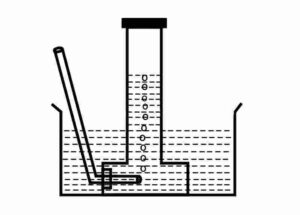Acids, Bases and Salts (अम्ल, क्षारक एवं लवण)
Get “Acids, Bases and Salts” chapter’s previous years questions from 2009 to 2020 of JAC board.
Q1. What is the natural source of tartaric acid?
{टार्टरिक अम्ल का प्राकृतिक स्रोत क्या है?}
Ans. Tamarind
{इमली}
Q2. What is the pH value of neutral solution?
{उदासीन विलयन का pH मान कितना होता है?}
Ans. 7
Q3. Which acid is found in orange?
{संतरे में कौन सा अम्ल पाया जाता है?}
Ans. Citric acid
(सिट्रिक अम्ल)
Q4. Name the sodium compound which is used for softening hard water.
{कठोर जल को मृदु बनाने में किस सोडियम यौगिक का उपयोग किया जाता है?}
Ans. Washing soda or Sodium carbonate
{धावन सोडा या सोडियम कार्बोनेट}
Q5. Write the chemical formula of bleaching powder.
{विरंजक चूर्ण का रासायनिक सूत्र लिखिए|}
Ans.
Q6. Write the chemical formula of washing soda.
{धोने का सोडा का रासायनिक सूत्र लिखिए|}
Ans.
Q7. Write the chemical name and formula of common salt.
{साधारण लवण का रासायनिक नाम और सूत्र लिखिए|}
Ans. Sodium chloride
{सोडियम क्लोराइड }
Q8. What is the common name of ?
{ का सामान्य नाम क्या है?}
Ans. Plaster of Paris
{प्लास्टर ऑफ़ पेरिस}
Q9. Write the chemical name of baking soda?
{बेकिंग सोडा का रासायनिक नाम लिखिए|}
Ans. Sodium hydrogencarbonate
{सोडियम हाइड्रोजन कार्बोनेट}
Q10. Which acid is found in tomato?
{टमाटर में कौन सा अम्ल पाया जाता है?}
Ans. Oxalic acid
{ऑक्सैलिक अम्ल}
Q11. Why hydrogen ions must always be show as ?
{क्यों हाइड्रोजन आयन के रूप में दर्शाया जाता हैं|}
Ans. Hydrogen ions cannot stay alone in the solution, so that they exist after reacting with water molecules
i.e
So, that’s why hydrogen ions must always be show as
{क्योंकि हाइड्रोजन आयन विलयन में अकेले नहीं रह सकते हैं, इसलिए वे पानी के अणुओं के साथ अभिक्रिया करने के बाद मौजूद रहते हैं
अर्थात
इसलिए, हाइड्रोजन आयनों के रूप में दर्शाया जाता हैं|}
Q12. compound
{ यौगिक}
Ans. Bleaching powder
{विरंजक चूर्ण}
Q13. State whether aqueous solution of washing soda is acidic or alkaline.
{धोवन सोडा का जलीय विलयन अम्लीय है या क्षारीय, बताएं|}
Ans. Alkaline
{क्षारीय}
Q14. What will happen if a solution of sodium hydrogencarbonate is heated?
{सोडियम हाइड्रोजन कार्बोनेट के विलयन को गर्म किया जाए तो क्या होगा?}
Ans. If a solution of sodium hydrogencarbonate is heated, we get sodium carbonate, carbon dioxide and water
i.e
{सोडियम हाइड्रोजन कार्बोनेट के विलयन को गर्म किया जाए तो हमें सोडियम कार्बोनेट, कार्बन डाइऑक्साइड और जल मिलता है|
अर्थात }
Q15. Write two important uses of bleaching powder.
{विरंजक चूर्ण के दो महत्वपूर्ण उपयोग लिखिए|}
Ans. (a) It is used in textile industry for bleaching cotton.
(b) It is used for disinfecting drinking water to make it germ free.
{(a) इसका उपयोग वस्त्र उद्योग में सूती के विरंजन के लिए किया जाता है|
(b) इसका उपयोग पीने वाले जल को जीवाणुओं से मुक्त करने के लिए रोगाणुनाशक के रूप में किया जाता है|}
Q16. The chemical reaction that takes place between acids and alkalies is called as neutralisation, why? Give an example.
{अम्ल और क्षारक के बीच की रासायनिक अभिक्रिया को उदासीनीकरण अभिक्रिया कहते है, क्यों? एक उदाहरण दें|}
Ans. The chemical reaction takes place between acids and alkalies produce salt and water. The effect of base is cancelled by acid and the effect of acid is cancelled by base. So that’s why this chemical reaction is called neutralisation reaction.
For ex:-
This reaction is neutralisation reaction.
{अम्ल और क्षार के बीच रासायनिक अभिक्रिया से नमक और जल बनता है| अम्ल द्वारा क्षार का प्रभाव और क्षार द्वारा अम्ल का प्रभाव नष्ट हो जाता है| इसलिए इस रासायनिक अभिक्रिया को उदासीनीकरण अभिक्रिया कहते हैं|}
उदाहरण के लिए:-
यह अभिक्रिया उदासीनीकरण अभिक्रिया है|}
Q17. Write two uses of baking soda.
{बेकिंग सोडा के दो उपयोग लिखिए|}
Ans. (a) Baking soda is an ingredient of antacids. Due to it’s alkaline nature, it neutralises excess acid and provides relief in stomach.
(b) It is used in soda-acid fire extinguishers.
{(a) बेकिंग सोडा ऐन्टैसिड (प्रति अम्ल) का एक संघटक है| अपनी क्षारीय प्रकृति के कारण यह पेट में अतिरिक्त अम्ल को निष्क्रिय कर राहत प्रदान करता है|
(b) इसका उपयोग सोडा-अम्ल अग्निशामक यंत्र में किया जाता है|}
Q18. How is plaster of paris prepared? Give any two uses of it.
{प्लास्टर ऑफ पेरिस कैसे तैयार किया जाता है? इसके कोई दो उपयोग बताएँ|}
Ans. On heating gypsum at 373K, it release water molecules and becomes calcium sulphate hemihydrate which is called “Plaster of Paris”
i.e
It’s used:-
(a) It is used as plaster for supporting fractured bones in the right position.
(b) It is used for manufacturing toy.
जिप्सम को 373K पर गर्म करने पर यह जल के अणुओं का त्याग कर कैल्शियम सल्फेट अर्धहाइड्रेट /हेमीहाइड्रेट बन जाता है जिसे “प्लास्टर ऑफ पेरिस” कहा जाता है।
अर्थात्,
इसका उपयोग किया जाता है:-
(a) टूटी हुई हड्डियों को सही जगह पर स्थिर रखने के लिए प्लास्टर के रूप में प्रयोग किया जाता है|
(b) इसका उपयोग खिलौना बनाने के लिए किया जाता है|}
Q19. Why do acids not show acidic behaviour in the absence of water?
{जल की अनुपस्थिति में अम्ल का व्यवहार अम्लीय क्यों नहीं होता?}
Ans. Hydrogen ions are generated in the presence of water. The separation of ions from acid molecules can not take place in the absence of water. So that’s why acid not show acidic behaviour in the absence of water.
For ex:-
{हाइड्रोजन आयन जल की उपस्थिति में उत्पन्न होते हैं| अम्ल के अणुओं से आयनों का पृथक्करण जल की अनुपस्थिति में नहीं हो सकता| अतः जल की अनुपस्थिति में अम्ल अम्लीय व्यवहार नहीं दिखाता है|
उदाहरण के लिए:- }
Q20. While diluting an acid, why is it recommended that acid should be added to water and not water to acid?
{अम्ल को तनुकृत करते समय यह क्यों अनुशंसित करते है कि अम्ल को जल में मिलाना चाहिए न कि जल को अम्ल में?}
Ans. The process of mixing an acid in water is an highly exothermic process. If water is mixed to a concentrated acid, the heat produced may cause the mixture to splash out and we may burn. The glass container may also break.
{जल में अम्ल के घुलने की प्रक्रिया अत्यधिक ऊष्माक्षेपी होती है| यदि सांद्र अम्ल में जल मिलाया जाये, तो उत्पन्न हुई ऊष्मा के कारण मिश्रण उछलकर बाहर आ सकता है और हम जल सकते हैं| साथ ही कांच का डिब्बा भी टूट सकता है|}
Q21. The pH value of cold drink is 4. What will be its action on the blue and red litmus solution?
{कोल्ड ड्रिंक का pH मान 4 है। नीले और लाल लिटमस के घोल पर इसकी क्या क्रिया होगी?}
Ans. It is acid and it turns blue litmus into red,
but there is no change in red litmus.
{यह अम्ल है और यह नीले लिटमस को लाल कर देगा ,
लेकिन लाल लिटमस में कोई परिवर्तन नहीं होगा|}
Q22. Why is distilled water not conduct electricity while rain water does?
{आसवित जल विघुत का चालन क्यों नहीं करता जबकि वर्षा जल करता है?}
Ans. Distilled water do not contain any ions which conduct electricity. But the rain water is acidic in nature which dissociates in ions and conducts electricity.
{आसवित जल में कोई आयन नहीं होता है जो बिजली का संचालन कर सके| लेकिन बारिश का पानी अम्लीय प्रकृति का होता है जो आयनों में अलग हो जाता है और बिजली का संचालन करता है|}
Q23. (a) How is bleaching powder prepared? Give the equation
(b) Why is bleaching powder poured into drinking water source?
{(a) विरंजक चूर्ण का निर्माण कैसे किया जाता है? समीकरण दीजिए
(b) विरंजक चूर्ण पीने के पानी के स्रोत में क्यों डाला जाता है?}
Ans. (a) Bleaching powder is prepared by the reaction of chlorine on dry slaked lime,
i.e
(b) Bleaching powder is used for disinfecting drinking water to make it germ free.
{(a) सूखे बुझे हुए चूने पर क्लोरीन की अभिक्रिया द्वारा ब्लीचिंग पाउडर तैयार किया जाता है,
अर्थात
(b) इसका उपयोग पीने वाले जल को जीवाणुओं से मुक्त करने के लिए रोगाणुनाशक के रूप में किया जाता है|}
Q24. A milkman adds a very small amount of baking soda to fresh milk.
(a) Why should he shift the pH of the fresh milk from 6 to slightly alkaline?
(b) Why does this milk take a long time to set as curd?
{एक ग्वाला ताजे दूध में थोड़ा बेकिंग सोडा मिलाता है|
(a) ताजे दूध के pH मान को 6 से बदलकर थोड़ा क्षारीय क्यों बना देता है?
(b) इस दूध को दही बनाने में अधिक समय क्यों लगता है?
Ans. (a) Milk is acidic in nature(pH=6) and it turns sour easily and become more acidic. Baking soda changes the pH of fresh milk from 6 to slightly alkaline so that it will not sour and spoil quickly.
(b) When the milk set to curd then pH value will decrease. When we add baking soda to it then it will first neutralises the pH then the pH is reduced to turns milk to curd. That’s why milk take a long time to set as curd.
{(a)दूध अम्लीय प्रकृति का होता है(pH=6) और यह आसानी से खट्टा हो जाता है और अधिक अम्लीय हो जाता है| बेकिंग सोडा ताजे दूध के pH को 6 से थोड़ा क्षारीय में बदल देता है ताकि यह जल्दी खट्टा और खराब न हो|}
(b) जब दूध दही में बदल जाता है तब उसका pH मान कम हो जाता हैं| जब हम उसमे बेकिंग सोडा मिलाते हैं तो यह पहले pH को उदासीन करेगा फिर दूध को दही में बदलने के लिए pH को घटाएगा| इसलिए दूध को दही बनने में काफी समय लगता है|}
Q25. What is neutralisation reaction? Give an example.
{उदासीनीकरण अभिक्रिया क्या है ? एक उदाहरण दें|}
Ans. The reaction of acid and base to produce salt and water is called neutralization reaction. In this, the effect of base is cancelled by acid and the effect of acid is cancelled by base.
For ex:-
{अम्ल और क्षार की लवण और जल बनाने की अभिक्रिया उदासीनीकरण अभिक्रिया कहलाती है| इसमें अम्ल द्वारा क्षार का प्रभाव और क्षार द्वारा अम्ल का प्रभाव निरस्त होता है|
उदाहरण के लिए:- }
Q26. Write two important uses of Plaster of Paris.
{प्लास्टर ऑफ पेरिस के दो महत्वपूर्ण उपयोग लिखिए|}
Ans. (a) It is used as plaster for supporting fractured bones in the right position.
(b) It is used for manufacturing toy.
{(a) टूटी हुई हड्डियों को सही जगह पर स्थिर रखने के लिए प्लास्टर के रूप में प्रयोग किया जाता है|
(b) इसका उपयोग खिलौना बनाने के लिए किया जाता है|}
Q27. What is alkali? Do basic solution also have (aq) ions? If yes, then why are these basic?
{क्षार क्या है? क्या क्षारकीय विलयन में भी (aq) आयन होते हैं? यदि हाँ, तो ये क्षारकीय क्यों होते हैं?}
Ans. Those bases which are soluble in water are called alkalis.
Basic solutions also have (aq) ions. But they are basic in nature because they have less concentration of
ions in comparison with
ions.
{वे क्षारक जो जल में घुलनशील होते हैं, क्षार कहलाते हैं|
क्षारकीय विलयन में भी (aq) आयन होते हैं|पर ये क्षारीय प्रकृति के होते हैं क्योंकि इनमें
आयनों की सांद्रता की तुलना में
आयनों की सांद्रता कम होती है|}
Q28. Write the chemical formula of the following
(a) Common salt
(b) Slaked lime
(c) Bleaching powder
{निम्नलिखित का रासायनिक सूत्र लिखिए
(a) साधारण नमक
(b) बुझा हुआ चूना
(c) विरंजक चूर्ण}
Ans.
Q29. What is gypsum? What happens when gypsum is heated to 373K?
{जिप्सम क्या होता है? इसको 373K ताप पर गर्म करने से क्या होता है?}
Ans. Gypsum is a salt which contains two water molecules as water of crystallisation.
On heating gypsum at 373K, it release water molecules and becomes calcium sulphate hemihydrate which is called “Plaster of Paris”
i.e
{जिप्सम एक नमक है जिसमें क्रिस्टल के जल के दो अणु होते हैं|
जिप्सम को 373K पर गर्म करने पर यह जल के अणुओं का त्याग कर कैल्शियम सल्फेट अर्धहाइड्रेट /हेमीहाइड्रेट बन जाता है जिसे “प्लास्टर ऑफ पेरिस” कहा जाता है।
अर्थात्, }.
Q30. A metal is treated with dilute acid. The gas evolved is collected by the method shown in the figure. Answer the following

(a) Name the gas.
(b) Name the method of collecting the gas.
(c) Is the gas soluble in water or not?
(d) Is the gas lighter or heavier than air?
(e) Write the chemical formula of the gas.
{किसी धातु की तनु अम्ल से क्रिया करायी जाती है| उत्सर्जित गैस को चित्र में दर्शाई गई विधि द्वारा से एकत्र किया जाता है| निम्नलिखित का उत्तर दें

(a) गैस का नाम बताए|
(b) गैस को एकत्र करने की विधि का नाम दें।
(c) क्या गैस पानी में विलेय है या नहीं?
(d) गैस हवा से हल्की या भारी है?
(e) गैस का रासायनिक सूत्र लिखिए।}
Ans. (a) Metal Acid
Salt
Hydrogen
Hydrogen gas is evolved.
(b) Downward displacement of water.
(c) Hydrogen gas is insoluble in water.
(d) Hydrogen gas is lighter than air.
(e)
{(a) धातु अम्ल
लवण
हाइड्रोजन
हाइड्रोजन गैस उत्सर्जित होगी|
(b) पानी का अधोमुखी विस्थापन|
(c) हाइड्रोजन गैस पानी में अविलेय है|
(d) हाइड्रोजन गैस हवा से हल्की होती है|
(e) }
9113323460

I hope you like it. If you like then please share it and you can also Donate to our website by my number and QR code which is given above.
Thanks.
